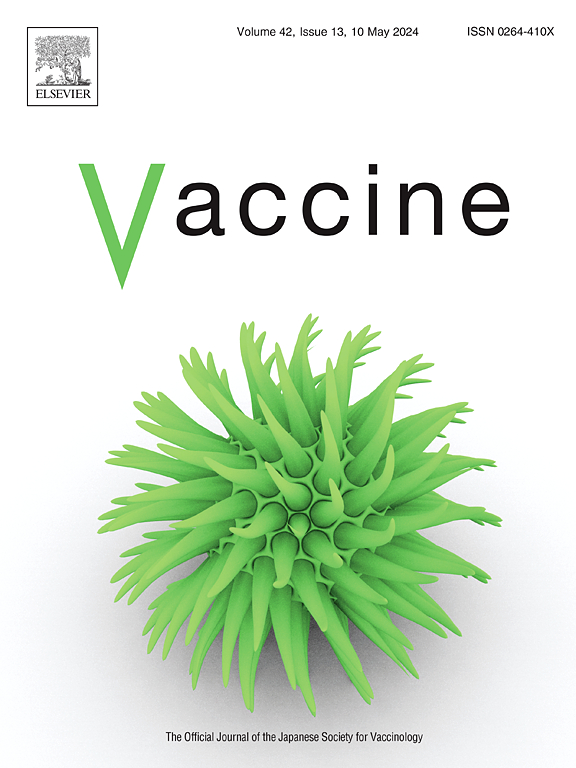探索在印度免疫规划下呼吸道合胞病毒(RSV)疫苗摄取的预测因素
IF 4.5
3区 医学
Q2 IMMUNOLOGY
引用次数: 0
摘要
在过去的十年中,孕产妇免疫(MI)得到了发展,保护母亲和后代免受传染病的侵害。在印度,根据普遍免疫规划(UIP),孕妇只有一种疫苗,即破伤风类毒素/破伤风和白喉疫苗。然而,通过在免疫计划中引入额外的母体疫苗,如呼吸道合胞病毒(RSV)疫苗,可以扩大MI篮子。因此,本研究的目的是探索在UIP下RSV疫苗摄取的潜在预测因素。本研究的相关数据提取自2019-21年进行的国家家庭健康调查(NFHS-5)。对过去5年内生育的15-49岁妇女的横截面样本进行了分析。采用双变量统计和logistic回归分析,采用Stata 17软件对妊娠晚期孕妇与医护人员互动的预测因素进行评估。该措施被用作衡量在妊娠晚期接种RSV等新疫苗的现有孕产妇保健交付平台的替代指标。结果来自174,483名女性的信息被纳入研究。其中,59.3%进行了四次或更多次产前保健(ANC)检查,相当大比例(83.8%)接受了破伤风注射。产前检查次数和怀孕期间破伤风注射次数是强有力的预测因素,在妊娠晚期,ANC访问频率较高,与卫生保健工作者(HCWs)会面的几率也较高。此外,较年轻的年龄(20-24岁)、中等财富指数组和农村地区的居住被认为是积极的预测因素,而较高的教育水平被认为是消极的预测因素。结论:本研究强调了产前检查和破伤风疫苗接种对妊娠晚期HCWs孕妇的重要性。这些因素表明已准备好采取潜在的干预措施,并建议利用ANC访问介绍RSV(一种新的孕产妇免疫疫苗)。本文章由计算机程序翻译,如有差异,请以英文原文为准。
Exploring the predictors for the uptake of Respiratory Syncytial Virus (RSV) vaccine under the immunization programme in India
Introduction
Maternal immunization (MI) has evolved over the past decade, protecting both mother and offspring from infectious diseases. In India, only one vaccine, tetanus toxoid (TT)/ tetanus and diphtheria (Td), is available under the Universal Immunization Programme (UIP) for pregnant women. However, the basket of MI can be expanded by introducing additional maternal vaccines such as the Respiratory Syncytial Virus (RSV) vaccine in the immunization schedule. Therefore, the study aims to explore the potential predictors for the uptake of the RSV vaccine under UIP.
Methodology
For the study, relevant data was extracted from the National Family Health Survey (NFHS-5) conducted during 2019–21. A cross-sectional sample of women aged 15–49 years who had given birth in the past 5 years was analyzed. Bivariate statistics and logistic regression analysis were employed to assess the predictors for pregnant women's interaction with healthcare workers (HCWs) during 3rd trimester of pregnancy using Stata 17 software. This measure was used as a proxy to gauge the existing maternal health delivery platform for new vaccine introductions, like RSV, administered during the third trimester.
Results
Information from 174,483 women was included in the study. Of them, 59.3 % went for four or more antenatal care (ANC) visits, and a significant proportion (83.8 %) received tetanus injections. The number of antenatal care visits and tetanus injections during pregnancy emerged as strong predictors, with higher ANC visit frequencies with increased odds of meeting with healthcare workers (HCWs) during the third trimester of pregnancy. Further, younger age (20–24 years), middle wealth index group, and residence in rural areas were identified as positive predictors while higher levels of education emerged as a negative predictor.
Conclusion
The study highlights the importance of ANC visits and tetanus vaccine uptake in engaging pregnant women with HCWs during the third trimester. These factors indicate readiness for potential interventions and suggest leveraging ANC visits for introducing RSV, a new maternal immunization vaccine.
求助全文
通过发布文献求助,成功后即可免费获取论文全文。
去求助
来源期刊

Vaccine
医学-免疫学
CiteScore
8.70
自引率
5.50%
发文量
992
审稿时长
131 days
期刊介绍:
Vaccine is unique in publishing the highest quality science across all disciplines relevant to the field of vaccinology - all original article submissions across basic and clinical research, vaccine manufacturing, history, public policy, behavioral science and ethics, social sciences, safety, and many other related areas are welcomed. The submission categories as given in the Guide for Authors indicate where we receive the most papers. Papers outside these major areas are also welcome and authors are encouraged to contact us with specific questions.
 求助内容:
求助内容: 应助结果提醒方式:
应助结果提醒方式:


